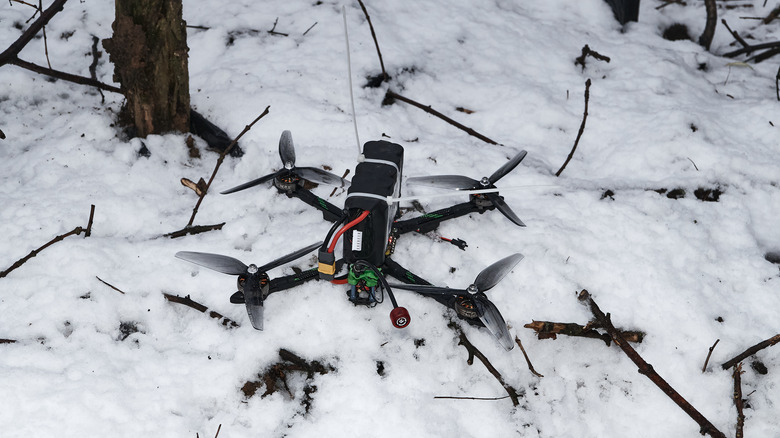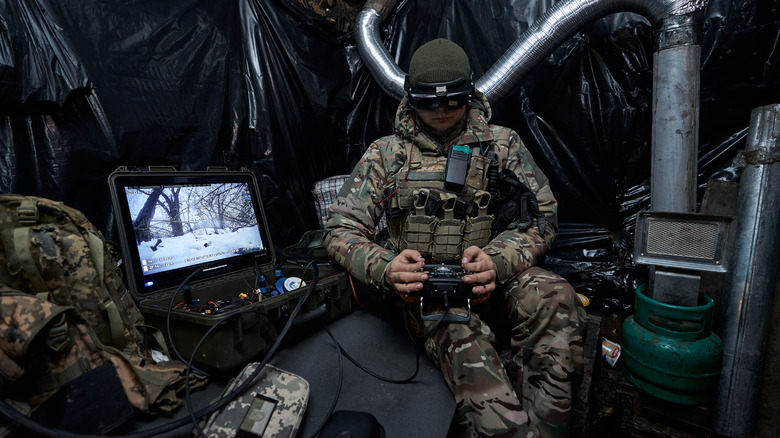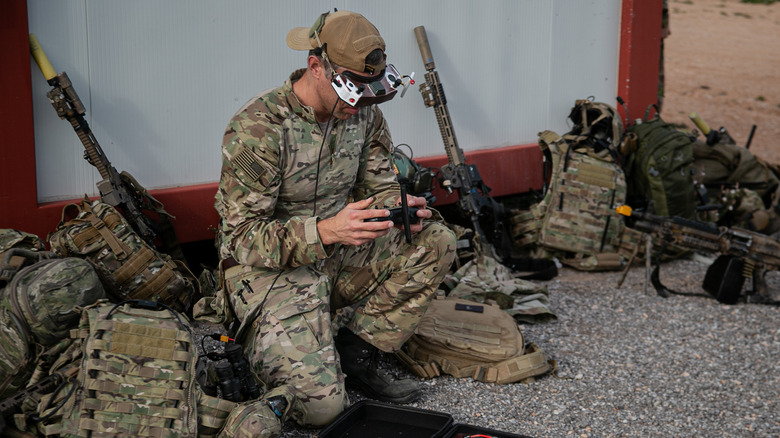Here's How FPV Loitering Munitions Work (And Why They're Changing The Battlefield)
With the War in Ukraine — the largest ground war Europe has seen since World War II — came several developments in the way battles are fought and won. Case in point, we've witnessed the introduction and rapid, widespread use of drones by both parties in the war, of which there are several types currently in use. Most prominently, "drone bombers" equipped with munitions under their bellies and release mechanisms to drop ordnance directly onto enemy positions as they fly overhead. However, one class of drones has proven exceptionally lethal and game-changing: the "first-person view" (FPV) drones.
Originally designed for hobbyist drone racing, FPV drones come paired with virtual reality headsets, allowing the pilot to experience a cockpit view through the drone's camera feed, even from miles away, like they're sitting in a "cockpit." In Ukraine, these drones have been adapted to carry munitions like grenades or rocket-propelled grenades. They're flown directly into targets, detonating on impact and destroying both themselves and their target, lending them morbid names like "suicide drones" or "kamikaze drones" as a result. Within just over two years, these brutal yet brutally effective weapons have claimed victims ranging from formidable T-90M tanks to entire squads of soldiers, proving their devastating impact on modern warfare. Here's what you need to know about this new type of weapon.
The Anatomy of an FPV Drone
Most of the FPV drones in use today by both Ukraine and Russia are commercial-grade FPV drones, such as the DJI FPV, which weigh no more than 800 grams. Yet, with beefy quad-rotors, they're capable of tearing through the air at speeds over 87 miles per hour unloaded. The speed is one part of the drone's lethality, making it difficult to shoot down and — for its victims — difficult to evade.
Pilots control these drones remotely via a joystick while wearing specialized FPV goggles that provide an immersive, first-person perspective through the drone's camera. This cockpit view allows for pinpoint accuracy, enabling the drones to be used for "sniping" targets through open hatches, doorways, and even windows.
Initially, these commercial drones were rigged with small payloads like Vog-17 grenades for anti-personnel roles or RKG-3 anti-tank grenades to take on vehicles. As the war progressed, more potent RPG-7 rounds were strapped to the drones and even custom explosively-formed penetrator (EFP) charges, which significantly boosted their anti-armor capabilities. This upgrade made them a formidable threat to tanks on both sides. Combat engineers have become highly resourceful in crafting detonators for the payload as well. Some rigs use two coiled wires hung in front of the drone, separated by an air gap. When the drone hits its target, the wires cross, completing the circuit and triggering the explosive. Recent iterations can be remotely detonated mid-air to create an airburst effect (a rain of lethal shrapnel) down on infantry.
FPV Drones are Kickstarting a Free-for-all Arms Race
More abundant than artillery shells, cheaper than guided bombs, and easier to effectively deploy than precision rifles or guided anti-tank missiles, war-dressed commercial FPV drones' key advantage lies in their accessibility. This has sparked a secret arms race among nations and militant groups since their introduction in 2022.
With the effectiveness of these drones having been demoed in conflicts from Ukraine to Israel and the Nagorno-Karabakh war between Azerbaijan and Armenia, militaries everywhere have taken note. The U.S. Marine Corps plans to field infantry-controlled loitering munitions by 2027, while the Army has conducted drone-racing exercises to familiarize soldiers with the technology at the brigade level. Institutionally, the Pentagon has established the Joint Counter Small Unmanned Aircraft University (C-sUAS) to train personnel in drone warfare. Other superpowers like China's People's Liberation Army have also begun conducting FPV drone training.
But the pursuit of this game-changing capability extends beyond just world powers. The very accessibility that catalyzed the arms race allows smaller states and even non-state actors to join. Sudan has augmented its forces with drones against paramilitary rebel groups since the 2023 Civil War. Even the Mexican cartels have been confirmed to be using these drones against rivals this past January. Like machine guns, tanks, and atomic weapons, the advent of these inexpensive drones on modern battlefields has promised to alter the landscape of warfare as we know it — and military leaders and analysts everywhere are taking note of this shift.


